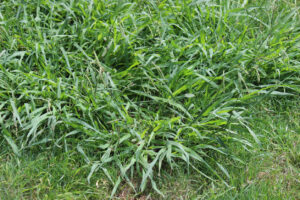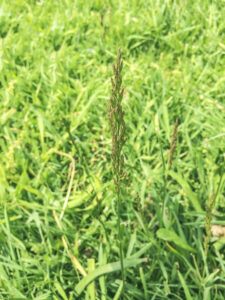Summer in Kentucky means fireworks, festivals, art fairs, and entertaining in your backyard. But the last thing you want to do is utilize your backyard for family fun entertainment if it is not up to par. Sometimes it’s not lawn disease or pests that wreak havoc on our turfs but uncontrollable grasses that creep up through our lawns and spread like wildfire.
Here in Kentucky, with our middle-of-the-road climate, we often use both warm-season and cool-season grasses together. Unfortunately, the warm-season grasses can become a nuisance. If left unchecked, they can spread quickly and overtake the cool-season grasses, such as Kentucky bluegrass. Learn how to identify five of the most common uncontrollable grasses that plague our Kentucky lawns and how a few yard maintenance tricks can help keep them away for good.
CONTACT US TODAY ABOUT LAWN SERVICES
Common Uncontrollable Grasses In Kentucky Lawns

Crabgrass
This lawn invader is often mistaken for bermudagrass. It begins germinating in mid-April and eventually dies off in the fall, but not before it causes problems for your turf. Crabgrass likes full sun and often pops up after you’ve mowed your lawn. Unlike bermudagrass, crabgrass grows in bunches. It also doesn’t have rhizomes. If you can easily dig up this weed and don’t see a strong root system underneath, it is most likely crabgrass.
It is a summer annual and reproduces both on the surface through seeds and beneath it through roots. Germinating in mid-April, it will eventually die off in the fall, but not before it wreaks havoc on your turf grass.
Bermudagrass
While bermudagrass is a popular grass in the south, it can quickly spread out of control when mixed with cool-season grasses. It has short leaf blades with dead leaf sheaths at each point. If left undisturbed, it will sprout small yellow flower clusters. This warm-season perennial spreads aggressively through both stolons and rhizomes, which makes it one of the toughest grasses to remove once it’s established in your lawn. It thrives in full sun and pops up shortly after you mowed. As fall approaches, it will go dormant and turn brown or purple.
Dallisgrass
Introduced in the 1800s to the U.S. as a fast-growing forage plant, this out-of-control weed liked our southern climate so much, it has been a problem for private and public lawns ever since. Dallisgrass has a coarse texture and grows in circular clumps, sometimes growing so large that the center dies out while the outer rings continue to smother all other turf grasses it encounters. It loves nitrogen fertilizer and grows faster than most grasses. Its short rhizomes root easily in moist soil making it difficult to control. Both pre and post-emergent are often needed to rid your lawn of this undesirable.
Broadleaved Plantain
Broadleaved plantain is a perennial broadleaf weed that grows from spring to fall. This challenging weed contains oval leaves with thick veins. These leaves are far wider than the traditional blades of grass of most other weeds, hence the first part of its name. Because it grows low to the ground, it tolerates low mowing, so cutting off the top of this weed will not eliminate it.
Broadleaved plantain is actually edible and serves many different medicinal purposes, so one way to get rid of it could be to add it to your dinner menu. But if you are like me and not willing to add this to your favorite meal, plucking it out with a weed-pulling tool should work. Broadleaved plantain typically spreads due to compacted soil. Therefore, your best option is to treat your lawn with liquid or core aeration.

Creeping Bentgrass
Unlike the others we’ve talked about, creeping bentgrass is cool-season grass. It is a low-growing grass that peaks in springtime. It has fine-bladed leaves and prefers shade over the sun; therefore, you will likely find this uncontrollable growing under bushes or trees.
Interestingly, creeping bentgrass is a popular turf grass for golf course putting greens. However, it’s not a great choice for most residential lawns due to its intense maintenance requirements. If it finds its way into your turf grass, it can become challenging to eradicate.
Best Practices For Controlling Unwanted Grasses
Don’t Mow Too Close to the Ground
Proper mowing is part of every good lawn care routine, but to prevent weeds from growing on your turf, you will want to set your mower at the correct height. Keep your mower set between two to three inches. The shorter you cut your grass, the easier it is for weeds to sprout. Most weeds need direct sunlight, therefore by cutting your lawn a little longer, you prevent weeds from receiving it.
Keep Your Kentucky Lawn Healthy
Nothing keeps out unwanted weeds and grasses more than a healthy lawn. When grass is nourished and kept at the correct height, weeds won’t have a chance to germinate. In addition to regular watering and mowing, you should also:
- Invest in a fertilization treatment program to keep your lawn healthy and robust.
- De-thatch in spring or fall to prevent compacted soil.
- Have your Kentucky lawn aerated once a year, allowing air, oxygen, and nutrients to reach your roots
- Overseed as needed to fill in bare or thinning patches.
- Dig out individual weeds or grasses, but make sure to dig down six inches to get at the root system
Consider Hiring Lawn Care Services
Trained and knowledgeable lawn care technicians can quickly identify which weeds are taking over your lawn and know how to treat them. While there are pre and post-emergent herbicides available at your local home goods stores, a lawn care service has the experience and know-how on which herbicides work best for specific weeds and the appropriate amount to use. Because herbicides can also kill the grass around your weeds, it’s best to leave applying them in the hands of the folks who do this for a living.
Keep Weeds Out of Your Kentucky Lawn With Weeding Services Through 2YardPros
We have the knowledgeable and trained technicians you are looking for at 2YardPros. We understand weeds, know how to identify them and how to eliminate them. Our Weeding Service can help you give you back your yard. We will first assess your lawn, determine what is causing the weed problem, and then get to the root and solve it. We also offer lawn Fertilization Treatment Programs that can help keep your lawn healthy and strong and better able to ward off these uncontrollable grasses in the first place. Learn more about both of these programs by contacting us via our website or giving us a call now. You can reach us at (502) 298-7828.
Did you like what you read? If so, share it with your family and friends. Then check out our other blog articles to learn more. Get to know us better by following us on Facebook and Twitter. And stop weeds from taking over your property now!